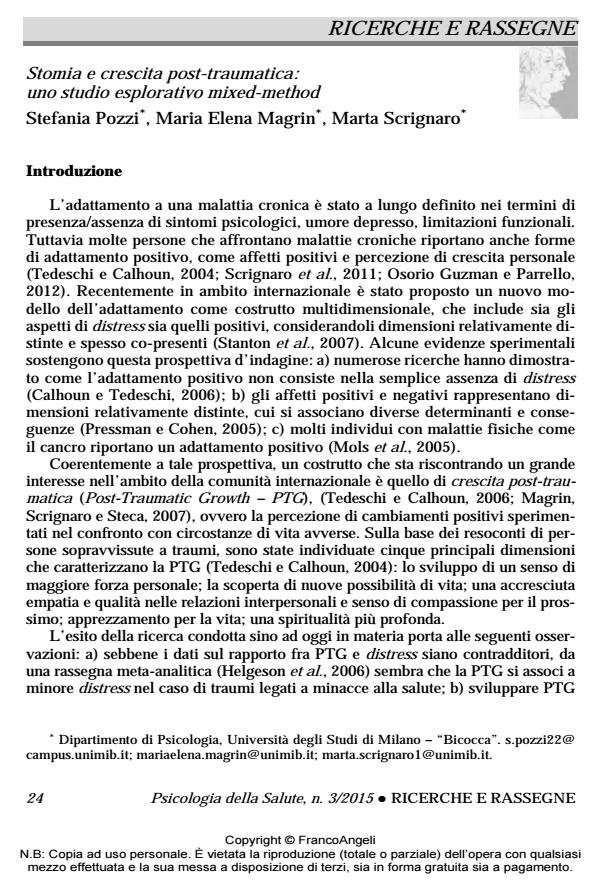Ostomy and Post-traumatic Growth: an explorative mixed-method study
Journal title PSICOLOGIA DELLA SALUTE
Author/s Stefania Pozzi, Maria Elena Magrin, Marta Scrignaro
Publishing Year 2015 Issue 2015/3
Language Italian Pages 21 P. 24-44 File size 145 KB
DOI 10.3280/PDS2015-003002
DOI is like a bar code for intellectual property: to have more infomation
click here
Below, you can see the article first page
If you want to buy this article in PDF format, you can do it, following the instructions to buy download credits

FrancoAngeli is member of Publishers International Linking Association, Inc (PILA), a not-for-profit association which run the CrossRef service enabling links to and from online scholarly content.
This paper investigates the presence of posttraumatic growth - PTG (Tedeschi and Calhoun, 2004) and the role of cognitive processes of deliberate vs intrusive rumination (Cann et al., 2011) in a group of ostomized people through qualitative and quantitative methodology. Participants (N = 39; 51% women) were administered a battery of questionnaires consisting of posttraumatic growth inventory (Tedeschi and Calhoun, 1996), intrusion scale of the Impact of Event Scale (Horowitz, 1979), intentional rumination scale of the event related rumination inventory (Cann et al., 2011), and a semi-structured interview about the history of life linked to the stoma, to which transcripts the coding system of autobiographical narratives (Pals and McAdams, 2004) and an exploratory analysis of content have been applied. The results support the idea that becoming ostomated can stimulate a sense of psychological growth that embraces both the domains described in the literature (Tedeschi and Calhoun, 2006) and an event-specific theme: "body awareness". Furthermore, deliberate rumination, but not intrusive thought, correlates with both quantitative (r = .53, p <.01) and qualitative (r = .40, p <.05) measure of PTG, supporting the model of PTG as made by a cognitive restructuring of the traumatic experience (Tedeschi and Calhoun, 2006). For clinical perspective, it seems useful to investigate the potential link between mindbody relationship and self-efficacy in the management of the stoma, as well as the mechanisms underlying the transition from intrusive type of rumination to more aware and constructive forms, able to accommodate not only the negative effects but also the improvement of the traumatic experience.
Keywords: Post-traumatic growth; deliberate rumination; intrusive rumination; ostomy; mixed-method
Stefania Pozzi, Maria Elena Magrin, Marta Scrignaro, Stomia e crescita post-traumatica: uno studio esplorativo mixed-method in "PSICOLOGIA DELLA SALUTE" 3/2015, pp 24-44, DOI: 10.3280/PDS2015-003002